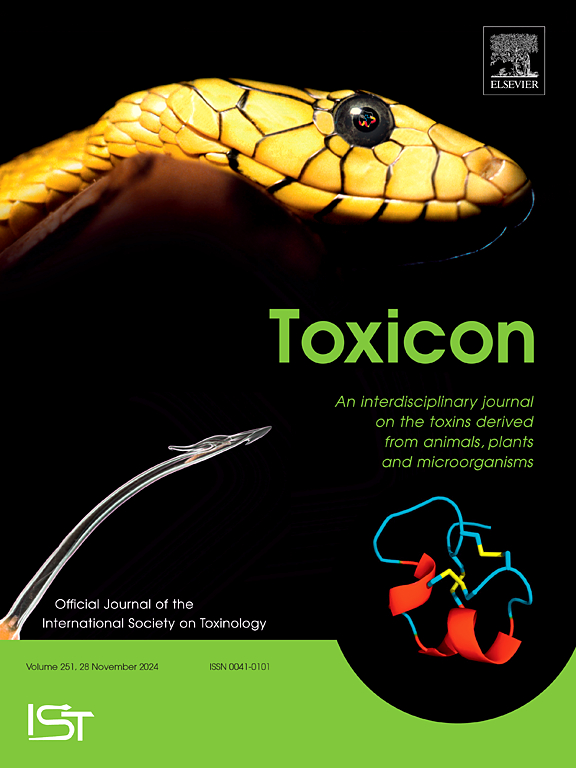Artificial intelligence application for identifying toxic plant species: A case of poisoning with Datura stramonium
IF 2.6
4区 医学
Q2 PHARMACOLOGY & PHARMACY
引用次数: 0
Abstract
Introduction
The management of plant poisonings in the emergency department (ED) presents various challenges. Foremost among these is the identification of the specific botanical species responsible for the toxic effect. In cases of plant poisoning, it is crucial to accurately identify the plant in order to promptly evaluate if it has cardiotoxic, neurotoxic, hepatotoxic, or anticholinergic properties. Furthermore, it is typically not possible to determine the identity of these plants through blood tests conducted in the ED.
Case report
An otherwise healthy 23-year-old male patient presented to the ED with symptoms of restlessness, altered mental state, and hallucinations that occurred 2 h after consuming herbal tea. On physical examination, he was tachypneic, tachycardic, and disoriented. The pupils were bilaterally mydriatic. The patient's symptoms were consistent with both sympathomimetic and anticholinergic (antimuscarinic) toxidromes. We were unable to promptly reach a botanist to identify the plant to which the patient had been exposed. Therefore, we employed Google Gemini, an artificial intelligence software, to ascertain the plant's identity. Google Gemini identified the plant we photographed as Datura stramonium, commonly known as jimson weed, which is known to cause anticholinergic toxicity. The botanist we contacted later confirmed that the plant was D. stramonium. The patient's symptoms were alleviated with the use of intravenous diazepam and physostigmine.
Conclusion
We propose that the utilization of artificial intelligence applications with visual recognition capabilities could be beneficial for physicians, patients, and foragers of edible wild plants to accurately identify plants and distinguish toxic species.

识别有毒植物物种的人工智能应用:曼陀罗中毒案例。
导言:急诊科(ED)在处理植物中毒事件时面临各种挑战。其中最主要的挑战是如何确定产生毒性作用的特定植物种类。在植物中毒病例中,准确识别植物至关重要,以便及时评估植物是否具有心脏毒性、神经毒性、肝毒性或抗胆碱能特性。此外,在急诊室进行的血液化验通常无法确定这些植物的身份:一名 23 岁的健康男性患者在饮用凉茶 2 小时后出现烦躁不安、精神状态改变和幻觉等症状,遂到急诊科就诊。体格检查时,他呼吸急促、心动过速、神志不清。双侧瞳孔散大。患者的症状与拟交感神经和抗胆碱能(抗心绞痛)中毒症状一致。我们无法及时联系到植物学家来鉴定患者接触过的植物。因此,我们使用人工智能软件谷歌双子座来确定该植物的身份。谷歌双子星确定我们拍摄的植物为曼陀罗(Datura stramonium),俗称金森草(jimson weed),已知会引起抗胆碱能毒性。我们后来联系的植物学家也证实了这种植物就是曼陀罗。通过静脉注射地西泮和扑尔敏,患者的症状得到了缓解:我们建议,利用具有视觉识别功能的人工智能应用软件可以帮助医生、患者和可食用野生植物的觅食者准确识别植物并区分有毒物种。
本文章由计算机程序翻译,如有差异,请以英文原文为准。
求助全文
约1分钟内获得全文
求助全文
来源期刊

Toxicon
医学-毒理学
CiteScore
4.80
自引率
10.70%
发文量
358
审稿时长
68 days
期刊介绍:
Toxicon has an open access mirror Toxicon: X, sharing the same aims and scope, editorial team, submission system and rigorous peer review. An introductory offer Toxicon: X - full waiver of the Open Access fee.
Toxicon''s "aims and scope" are to publish:
-articles containing the results of original research on problems related to toxins derived from animals, plants and microorganisms
-papers on novel findings related to the chemical, pharmacological, toxicological, and immunological properties of natural toxins
-molecular biological studies of toxins and other genes from poisonous and venomous organisms that advance understanding of the role or function of toxins
-clinical observations on poisoning and envenoming where a new therapeutic principle has been proposed or a decidedly superior clinical result has been obtained.
-material on the use of toxins as tools in studying biological processes and material on subjects related to venom and antivenom problems.
-articles on the translational application of toxins, for example as drugs and insecticides
-epidemiological studies on envenoming or poisoning, so long as they highlight a previously unrecognised medical problem or provide insight into the prevention or medical treatment of envenoming or poisoning. Retrospective surveys of hospital records, especially those lacking species identification, will not be considered for publication. Properly designed prospective community-based surveys are strongly encouraged.
-articles describing well-known activities of venoms, such as antibacterial, anticancer, and analgesic activities of arachnid venoms, without any attempt to define the mechanism of action or purify the active component, will not be considered for publication in Toxicon.
-review articles on problems related to toxinology.
To encourage the exchange of ideas, sections of the journal may be devoted to Short Communications, Letters to the Editor and activities of the affiliated societies.
 求助内容:
求助内容: 应助结果提醒方式:
应助结果提醒方式:


